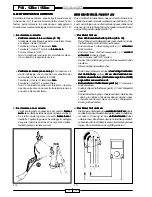
15
11/00
F18 - 125
F18 - 125
F18 - 125
F18 - 125
F18 - 125cc / 150cc
cc / 150cc
cc / 150cc
cc / 150cc
cc / 150cc
EL MOTOR ARRANCA
EL MOTOR ARRANCA
EL MOTOR ARRANCA
EL MOTOR ARRANCA
EL MOTOR ARRANCA
SOLO CON LA PALANCA
SOLO CON LA PALANCA
SOLO CON LA PALANCA
SOLO CON LA PALANCA
SOLO CON LA PALANCA
KICK-STARTER
KICK-STARTER
KICK-STARTER
KICK-STARTER
KICK-STARTER
a) Controlar la carga de la batería.
Controlar la carga de la batería.
Controlar la carga de la batería.
Controlar la carga de la batería.
Controlar la carga de la batería.
- La tensión no debe ser inferior a
12,5 V.
12,5 V.
12,5 V.
12,5 V.
12,5 V.
- Densidad electrólita: 1,269 gr/cm
1,269 gr/cm
1,269 gr/cm
1,269 gr/cm
1,269 gr/cm
3
33
33
a 20°C.
a 20°C.
a 20°C.
a 20°C.
a 20°C.
1) Controlar el nivel y eventualmente
restablecerlo con agua destilada.
2) Controlar que no hayan residuos
de sulfatación.
3) Eventualmente sustituir la
batería.
c) Control interruptor estárter
Control interruptor estárter
Control interruptor estárter
Control interruptor estárter
Control interruptor estárter
(F. 10).
(F. 10).
(F. 10).
(F. 10).
(F. 10).
- Desmontar el cubremanillar
superior.
- Desconectar el conector de 6 vías
del conmutador derecho y
conectar el tester (
tester (
tester (
tester (
tester (
Ω
Ω
Ω
Ω
Ω
x 1).
x 1).
x 1).
x 1).
x 1).
- Terminal (+) tester
→
cable
blanco/rojo
blanco/rojo
blanco/rojo
blanco/rojo
blanco/rojo.
- Terminal (-) tester
→
cable negro
negro
negro
negro
negro.
- Apretar el botón “Start”.
- No hay continuidad: sustituir el
conmutador derecho.
- Hay continuidad: continuar la
búsqueda.
b) Control motor de arranque
Control motor de arranque
Control motor de arranque
Control motor de arranque
Control motor de arranque
(F. 9).
(F. 9).
(F. 9).
(F. 9).
(F. 9).
- Conectar directamente el cable
(+) de la batería a la lengüeta del
motor de arranque y el cable (-)
en masa sobre el chasís.
-
El motor de arranque no funciona:
sustituirlo.
-
Funciona: continuar la búsqueda.
THE ENGINE STARTS
THE ENGINE STARTS
THE ENGINE STARTS
THE ENGINE STARTS
THE ENGINE STARTS
ONLY WITH THE KICK-
ONLY WITH THE KICK-
ONLY WITH THE KICK-
ONLY WITH THE KICK-
ONLY WITH THE KICK-
STARTER LEVER
STARTER LEVER
STARTER LEVER
STARTER LEVER
STARTER LEVER
a) Check the battery charge
Check the battery charge
Check the battery charge
Check the battery charge
Check the battery charge.....
- Voltage must not be below
12.5 V.
12.5 V.
12.5 V.
12.5 V.
12.5 V.
- Electrolyte density: 1.269 gr/cm
1.269 gr/cm
1.269 gr/cm
1.269 gr/cm
1.269 gr/cm
3
33
33
with 20°C.
with 20°C.
with 20°C.
with 20°C.
with 20°C.
1) Check the level and if necessary
fill it with distilled water.
2) Check if sulphation marks are
present.
3) If necessary, replace the battery.
b) Starting motor check
Starting motor check
Starting motor check
Starting motor check
Starting motor check
(F. 9).
(F. 9).
(F. 9).
(F. 9).
(F. 9).
- Connect the battery cable (+)
directly to the starting motor key
and the cable (-) grounded to
frame.
-
The starting motor does not run:
replace it.
-
The starting motor runs: continue
searching.
c) Starter switch check
Starter switch check
Starter switch check
Starter switch check
Starter switch check
(F. 10).
(F. 10).
(F. 10).
(F. 10).
(F. 10).
- Remove the upper handlebar
cover.
- Disconnect the 6-way connector
of the right change-over switch
and connect the tester (
tester (
tester (
tester (
tester (
Ω
Ω
Ω
Ω
Ω
x 1).
x 1).
x 1).
x 1).
x 1).
- Tester terminal (+)
→
white/red
white/red
white/red
white/red
white/red
cable.
- Tester terminal (-)
→
black
black
black
black
black cable.
- Press the “Start” switch.
- No continuity: replace the right
change-over switch.
- Continuity: continue searching.
LE MOTEUR NE DEMARRE
LE MOTEUR NE DEMARRE
LE MOTEUR NE DEMARRE
LE MOTEUR NE DEMARRE
LE MOTEUR NE DEMARRE
QU’AVEC LA PEDALE DE
QU’AVEC LA PEDALE DE
QU’AVEC LA PEDALE DE
QU’AVEC LA PEDALE DE
QU’AVEC LA PEDALE DE
KICK
KICK
KICK
KICK
KICK
a) Contrôler la charge de la batterie.
Contrôler la charge de la batterie.
Contrôler la charge de la batterie.
Contrôler la charge de la batterie.
Contrôler la charge de la batterie.
- La tension doit être au minimum
de 12,5 V.
12,5 V.
12,5 V.
12,5 V.
12,5 V.
- Densité électrolyte : 1,269 g/cm
1,269 g/cm
1,269 g/cm
1,269 g/cm
1,269 g/cm
3
33
33
à 20°C.
à 20°C.
à 20°C.
à 20°C.
à 20°C.
1) Contrôler le niveau et éventuelle-
ment remettre à niveau en
ajoutant de l’eau distillée.
2) Contrôler s’il y a traces de
sulfatation.
3) Eventuellement changer la
batterie.
b) Contrôle démarreur
Contrôle démarreur
Contrôle démarreur
Contrôle démarreur
Contrôle démarreur
(F. 9).
(F. 9).
(F. 9).
(F. 9).
(F. 9).
- Connecter directement le petit
câble (+) de la batterie à la lan-
guette du démarreur et le petit
câble (-) à masse sur le châssis.
- Le démarreur ne marche pas : le
changer.
- Le démarreur marche : poursui-
vre la recherche.
c) Contrôle interrupteur démarreur
Contrôle interrupteur démarreur
Contrôle interrupteur démarreur
Contrôle interrupteur démarreur
Contrôle interrupteur démarreur
(F. 10).
(F. 10).
(F. 10).
(F. 10).
(F. 10).
- Démonter le couvre-guidon
supérieur.
- Déconnecter le connecteur à 6
voies du commutateur droit et
connecter le testeur (
( (
(
(
Ω
Ω
Ω
Ω
Ω
x 1).
x 1).
x 1).
x 1).
x 1).
- Borne (+) testeur
→
câble blanc/
blanc/
blanc/
blanc/
blanc/
rouge
rouge
rouge
rouge
rouge.
- Borne (-) testeur
→
câble noir
noir
noir
noir
noir.
- Appuyer sur la touche “Départ”.
- Pas de continuité : changer le
commutateur droit.
- Continuité : poursuivre la
recherche.
Содержание F18 WARRIOR
Страница 63: ...62 11 00 NOTES NOTES NOTES NOTES NOTES...
















































